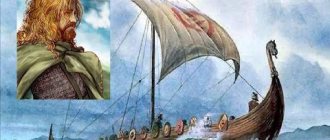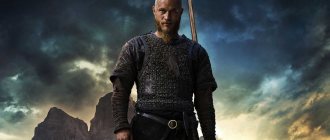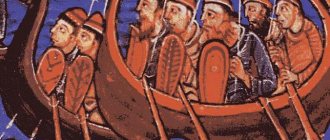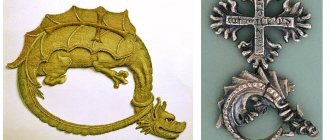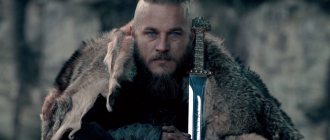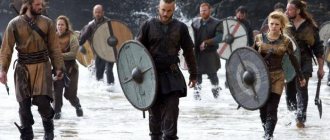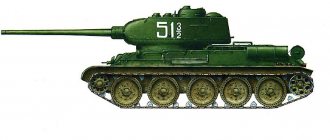Sigurd the Snake-Eyed, also known as Sigurd the Serpent in the Eye, was a famous Danish king and one of the legendary sons of Ragnar Lothbrok, the sea king. Aslaug was the daughter of Sigurd Fafnir-Slayer and the mother of Sigurd Snake-Eyes. The child born to the woman was distinguished from other children by a special mark in the eye, reminiscent of a snake biting its own tail, and was called Ouroboros. Sigurd's equally revered brothers were Bjorn Ironside, Ivar the Boneless, Ubba and Halfdan.
Modern researchers believe that the mark in Sigurd's eye appeared as a result of a congenital gene mutation.
Growing up, Sigurd became increasingly attached to his great father, trying to follow his example and imitate him, but later he lived for some time on the islands of Scotland.
Legendary early Vikings
Historians trace the beginning of the “Viking Age” to June 8, 793, when a detachment of sea robbers (presumably Norwegians) landed on the British island of Lindisfarne, robbing the monastery of St. Cuthbert. This is the first Viking attack clearly recorded in written sources.
The Viking Age can be divided into three periods. The early period (793–891) is the most romantic, when risky residents of Denmark, Norway and Sweden put together “free squads” to raid more prosperous lands. Some managed to make geographical discoveries - for example, the Norwegian Vikings founded several settlements in Iceland. The first large-scale Viking campaign in Western Europe occurred in the early period - an attempt by the “great pagan army” to conquer England. The period ends with a temporary attenuation of the external expansion of the Normans (“northern people” - as the Scandinavians were called by the Europeans), when the Vikings suffered several military defeats: the largest happened in 891 at Leuven, where they were defeated by the East Franks.
Ragnar "Leather Pants" Lothbrok
Ragnar Lothbrok played by Travis Fimmel (TV series "Vikings")
Legend : Son of the Swedish king Sigurd Ring and brother of the Danish king Gudfred. The nickname stems from the fact that Ragnar wore leather pants made by his wife Lagertha, considering them lucky. From a young age, Ragnar took part in many campaigns, gaining the authority of the great “sea king”. In 845 he assembled a huge squad for a raid on Western France. On March 28, Paris was captured, and the Frankish king Charles the Bald, in order to protect the capital from destruction, paid a ransom of seven thousand silver livres. In 865, Ragnar set off to plunder England. But the flotilla was scattered by a storm, and the king's ship ran aground. Ragnar was captured and taken to the court of King Aella of Northumbria, who ordered the Norman leader to be thrown into a pit with poisonous snakes.
Dying, Ragnar exclaimed: “How my dear piglets would grunt if they knew what it’s like for me, the old boar!”, hinting at the revenge of his sons. And they did not disappoint - they gathered a huge army, known as the “great pagan army,” and in 867 they attacked Britain. They captured and brutally executed King Aella, plundered Northumbria, Mercia and East Anglia. Only the King of Wessex, Alfred the Great, was able to stop the expansion of the “great army,” partly by sword and partly by diplomacy.
Ragnar Lothbrok wooing his third wife Aslaug (painting by August Maelström, 1880)
History : The existence of Ragnar is not fully confirmed; we know about him mainly from the Scandinavian sagas. As for the written chronicles of Western Europeans, which tell about events related to the possible deeds of Ragnar, they either do not mention his name, or were generally created in much later times.
Epitaph : Classic Viking adventurer. A man of noble origin, he achieved everything himself - thanks to military skills and personal courage. Having obtained enormous wealth during his campaigns, Ragnar built his own kingdom, taking control of part of the Danish and Swedish lands. However, he remained a robber at heart. Otherwise, it is difficult to explain his last adventure, when he, already at an advanced age, went to “fool around” in Northumbria.
Bjorn Ironside
Legend : Son of Ragnar Lothbrok, king of Sweden, founder of the Munsø dynasty (named after the hill where he is buried). The nickname is associated with the captured metal armor that Bjorn wore in battle. He became famous for his campaigns in the southern lands: in 860 he ravaged the Mediterranean coast of Morocco, plundered Provence, Spain and Italy. But in a clash with the Saracen squadron he failed - using “Greek fire” unknown to the Vikings, the Moors burned forty ships. In 867, Bjorn was one of the commanders of the “great army”, but did not stay in England for long.
History : The main source is sagas. However, several Frankish chronicles mention a Viking leader named Berno.
Epitaph : A very sensible Viking. He wore metal armor - and it doesn’t matter that the Vikings didn’t do that. Faced with the “Greek fire” of the Moors, he did not destroy the fleet and retreated. He preferred “bird in hand” - dominion over Sweden - to “pie in the sky” (the conquest of England).
Sword of a warrior of the "great heathen army", found at Repton (formerly Mercia)
Ivar the Boneless
Legend : Son of Ragnar Lothbrok. Almost the only leader known as a berserker. There are two versions about the nickname: the first is associated with an illness (possibly impotence or bone disease), the second with the fighting skill of Ivar, dexterous and flexible, like a snake. He was one of the commanders of the “great army”, distinguished by his leadership talents and cruelty. Tortured and then killed King Aelle. In 870 he ordered the assassination of King Edmund of East Anglia. He died in 873, being the ruler of the Irish city of Dublin.
History : In addition to the sagas and Anglo-Saxon chronicles, he is mentioned in the Annals of Ireland, where the date of his death is indicated - moreover, from a “terrible illness”.
Epitaph : Viking maniac, inhumanly cruel barbarian. Western chroniclers portray him as a fan of the famous “bloody eagle” execution - although modern historians deny its existence.
Sigurd Snake-Eyes
Legend : Son of Ragnar Lothbrok. The nickname arose from the fact that Sigurd was born with a mark in his eye (a ring around the pupil), which evoked associations with Ouroboros, a mythological serpent that swallows its own tail. Ragnar's favorite, after the death of his father, he inherited a fair part of his lands. He was one of the leaders of the “great army”. He married Blaja, daughter of King Aella, the killer of Ragnar Lothbrok. It is difficult to say how voluntary the marriage was, because Blaya was captured after the death of her father. However, Sigurd was with her for many years, having fathered four legitimate children. After returning from Britain, he quarreled with King Ernulf and died in battle in 890.
History : Known only from sagas.
Epitaph : "Soft" version of the Viking. A dashing fighter, but he became famous as a zealous landowner and a good family man.
Capture of Paris by Ragnar Lothbrok (19th century painting)
Halfdan Ragnarsson
Legend : Son of Ragnar Lothbrok (possibly by a concubine). In 870 he became the sole commander of the "great army" and tried to conquer Wessex, but was unsuccessful. In 874 he captured the West English kingdom of Mercia. After this, the “great army” disintegrated, and Halfdan with half the troops went to Scotland, and then to Ireland, where he declared himself king of Dublin. Constantly organized new trips. During one of them, a revolt of the Vikings who remained there broke out in Ireland. In 877, Halfdan fought with the rebels at Strangford Lough, was defeated and died.
History : In addition to the sagas, it is mentioned in Anglo-Saxon and Irish chronicles.
Epitaph : An ambitious Viking with a thirst for great achievements. Perhaps his fierce desire to ascend is due precisely to his “illegal” origin (even his name means “half-Danish” - a hint that Halfdan’s mother was a foreigner, not from Scandinavia).
Guthrum the Old
Legend : Danish Viking, participant in the campaign of the “great army”, during which he gained considerable fame, so that when the army split in 875, he led half of it. He successfully fought with Wessex, but after the defeat at Ethandun he chose to make peace and was baptized under the name Athelstan. In 880 he became king of East Anglia. He ruled until his death in 890, managing to transfer the throne to his son Eorik.
History : In addition to the sagas, it is repeatedly mentioned in the Anglo-Saxon chronicles; coins minted under it have also been preserved. The nickname "Old" was given to him by modern historians to distinguish him from another king of East Anglia, Guthrum, who reigned at the beginning of the 10th century.
Epitaph : A Viking of humble birth who managed to rise to the occasion thanks to his intelligence and military talents. As a result, he became king and passed on power by inheritance.
Real Viking ship in the Oslo Museum
Ubba Ragnarsson
Legend : Son of Ragnar Lothbrok. One of the leaders of the “great army”, participant in the assassination of King Edmund of East Anglia. He was a good fighter, but had no other talents. When the “great army” split, he remained under the command of Guthrum. In 878 he went to Somerset. After the landing, he was defeated at the Battle of Kinvinta, where he died.
History : Mentioned in the sagas, as well as in the Anglo-Saxon Chronicles.
Epitaph : A brave and cruel fighter “without a king in his head”, capable only of fighting.
Gutfried of Frisia
Legend : Danish jarl, participant in the campaign of the “great army”. Having obtained a lot of goods in England, he assembled a squad, with the help of which he captured Frisia (a province on the border with Denmark) in 880. In 882 he ravaged Maastricht, Liege, Cologne, Trier, Metz and Aachen. Emperor Charles III the Thick made peace with Gutfried, granted him the title of Duke of Frisia, after which the seasoned robber took a vassal oath and was baptized. However, Gutfried turned a blind eye to the raids of other Vikings. The emperor's patience ran out, and in 885 he accused Gutfried of treason, after which he was killed by a group of Frisian nobles.
History : Often mentioned in chronicles - so the person is historical.
Epitaph : Viking condottiere. He got rich from robberies, gathered a squad, seized lands, began to serve the emperor... And then he betrayed - or was accused of treason. And he was killed - the famous mercenary Albrecht Wallenstein ended up in exactly the same way.
Vikings on a campaign (painting by Nicholas Roerich “Overseas Guests”, 1901)
Hastein
Legend : Probably Danish. According to one version, he is the son of a small farmer, according to another, he is a relative of Ragnar Lothbrok. An experienced warrior, he was the mentor of Bjorn Ironside, with whom he plundered France, Spain, Italy and Morocco. Then, alone, he returned to France, where he became a mercenary for the Duke of Breton. In 866 he defeated the Franks at Brissart. In 890 he moved to Flanders. Two years later he led the Viking army, which again tried to conquer England. He plundered many English lands, but, deciding not to try his luck anymore, he returned to France, where he died a few years later.
History : There are many records of Hastein in the Frankish and Anglo-Saxon chronicles, so his reality is proven. True, there is a possibility that there were two people with that name. If Hastein, who fought with Alfred the Great, was the mentor of Bjorn Ironside, then during the English campaign he should have been over seventy (very old at that time). However, this is possible.
Epitaph : One of the greatest “sea kings” - he robbed for a long time and with impunity, filled his pockets and died in his bed.
Rorik of Jutland
Rorik of Jutland (painting by Willem Koekkoek, 1912)
Legend : Nephew (according to another version - brother) of the King of Jutland Harald Klak. From a young age he was a mercenary in the service of the Frankish king Lothair, who fought against his father and brothers. After the strife between the Franks subsided, Lothair decided to get rid of Rorik and threw him into prison. But he fled and in 850 captured Dorestad and Utrecht. Lothair was forced to make peace - on the condition that the formidable Dane would defend the northern lands of the Franks from other Vikings. Around 857–862, Rorik conquered the Vendian Slavs and also captured part of Lorraine. Died between 879 and 882.
History : Rorik of Jutland is mentioned several times in the Frankish annals. Since the 19th century, a number of historians have identified him with Rurik, the Varangian known from the Tale of Bygone Years, who founded the ancient Russian princely dynasty. After all, Rorik is the only famous Viking with a similar name who lived during the same period. In addition, in 863-870, the name of Rurik disappeared from the Frankish chronicles - at the same time, according to Russian chronicles, Rurik of Novgorod appeared. Among modern Russian historians, this version has both supporters and opponents.
Epitaph : The most successful Viking who served the Carolingians. Starting as a mercenary, he built his own state. In general, life was good - even if we do not take into account the hypothesis that he was the founder of the Rurikovich dynasty.
Why was he given such a nickname?
Opinions among historians and scholars of Scandinavian epics differ when the debate begins as to why Sigurd Snake-Eyes (Sigurd the Serpent in the Eye) received such an unusual nickname. Here are some of the most convincing versions:
- The child was born with an eyesore resembling the eye of a snake - hence the nickname.
- Sigurd Snake-Eyes had an unusual iris on one eye: around the pupil there was a ring reminiscent of an Ouroboros - a snake biting its tail.
- Ancient tales tell of the piercing, meticulous gaze inherent in all of Ragnar's children, and his father too. Perhaps that is why the corresponding nickname was given.
- Modern researchers suggest that Sigurd Snake-Eyes was a carrier of the rare Pax6 gene, which manifested itself in the partial or complete absence of the iris. Therefore, the wearer’s gaze was quite specific and frightening.
Legendary Vikings of the Middle Period
The middle period of the Viking Age (891–980) is associated with the formation of centralized states in Scandinavia. At that time, the Normans fought with each other - the more successful became kings, the defeated sought happiness in other lands. The end of the period is considered to be 980, when the Normans, having overcome internal unrest, resumed expansion, but in a more “state” format.
Harald Fairhair
Statue of Harald Fairhair in Oslo (sculptor Nils Aas)
Legend : Son of Halfdan the Black, king of the province of Vestfold. His youth was spent in endless battles with local jarls, the apotheosis of which was the Battle of Hafsfjord (872). After the victory, Harald declared himself king of a united Norway, subsequently subjugated the Orkney and Shetland Islands, and fought with the Swedes. He died in 933 (according to other sources - in 940). The nickname appeared because of the luxurious hair that Harald was proud of.
History : Although only sagas tell about Harald's life, scholars recognize him as a real figure.
Epitaph : The first Scandinavian king, who can be compared with the kings of Western Europe. So, he organized a full-fledged tax system, which, by the way, caused Norwegians dissatisfied with this to flee en masse to Iceland.
Rollon Pedestrian
Statue of Rollo on the façade of Rouen Cathedral, where his tomb is located
Legend : The son of the Norwegian jarl Rognvald, real name Rolf (or Hrolf) - the Franks called him Rollon. He was nicknamed the Pedestrian because no horse could carry his massive bulk. Rolf's father lost his lands during the unification of Norway under the leadership of Harald Fairhair, but became Earl of Orkney and Shetland. Rolf was the youngest son, so he decided to try his luck as a Viking and gathered a squad with which he plundered Western France for many years. In 911, King Charles III the Simple gave Rollon Rouen, Brittany, Caen, Er and gave his daughter Gisela as his wife. In return, Rollo was baptized under the name of Robert, recognizing the King of France as his lord. This is how the Norman Duchy appeared, which became hereditary. Rollo died around 932 and was buried in Rouen Cathedral.
History : A real character about whom there are many references in written sources.
Epitaph : The Viking Ideal. Thanks to his daring and intelligence, he founded a ruling dynasty, whose members played a significant role in Western European politics for many centuries.
Eric Bloodaxe
Legend : King of Norway, beloved son and heir of Harald Fairhair. He became famous both for his military exploits and his atrocities. He killed three of his brothers, but lost the war with the fourth, after which he fled from Norway to Britain, where he became king of Northumbria. In 954 he tried to conquer Ireland, but was defeated and died in battle (according to another version, he was killed by conspirators in York).
History : Mentioned in both sagas and chronicles, where he is called “fratricide.” There are also coins minted in Northumbria bearing the name Eric. However, some information about him contradicts each other.
Epitaph : “Dark Lord” of the Vikings, a cruel tyrant, capable of any atrocity.
Eric the Red
Legend : A Norwegian Viking with a violent temperament, he killed other Normans several times. He was expelled first from Norway, then from Iceland. In 980 he sailed west, where he discovered a land he named Greenland. Returning to Iceland, he recruited settlers and sailed with them again to Greenland. There he founded the settlement of Brattalid (near the modern village of Narsarsuaq), where he died in 1003.
History : In addition to the sagas, the story of Eric the Red is confirmed by archaeological finds.
Epitaph : Vikings are not necessarily robbers; there were many brave pioneers among them. Eric the Red is just such a researcher, albeit unwillingly.
Eric the Red's farm in Greenland (modern reconstruction)
Egil Skallagrimsson
Legend : Great Icelandic skald, son of a Norwegian settler. He was considered a berserker and fought several times in holmgangs (Viking duels). He killed several Normans, in particular, the brother of Gunnhild, the wife of Eric Bloodaxe, who declared Egil an outlaw. He pirated in the Baltic lands, then moved to England. He distinguished himself at the Battle of Brunanburg (937), where he fought for the English king Ettelstan. Having lived a long life, he died around 990 in his native Iceland.
History : The main sources are sagas, including his own.
Epitaph : Considered the greatest poet of the Viking Age. He was the first skald to use end rhyme. Three of Egil's sagas, several poetic fragments, and about fifty vis (short poems) have survived.
Eric the Red
One of the few Vikings who became famous not thanks to their bloodthirsty raids and robberies, but in connection with significant geographical discoveries. Eric Thorvaldson, who got his nickname because of the color of his hair and beard, had a bad character and violent disposition. He was born in 950 in Norway, from where he was subsequently exiled to Iceland for murder. However, troubles continued in the new place. Around 980, Erik was sentenced to three years of exile from Iceland, also for murder. In one case, he killed a neighbor who did not want to return a borrowed boat, in another, he avenged his slaves killed by another Viking.
Fulfilling the sentence, Eric, along with his family, servants and livestock, sailed west to lands lying 280 km from the Icelandic coast. Throughout his three years of exile, Eric never met a single person on this new land, although in his travels along the coast he went very far from the southern tip of Greenland.
At the end of his exile in 986, Erik returned to Iceland and began encouraging local Vikings to move to new lands, which he called Greenland. Concerning this name, modern historians and scientists still continue to debate. Some believe that at that time the climate in these places was milder, due to which the coastal areas of the southwest of the island were indeed covered with dense grassy vegetation. Others believe that Eric specifically named the cold and deserted island that way in order to attract more settlers to it.
Legendary Vikings of the Late Period
The late period of the Viking Age (980–1066) is called the “era of the Viking kings”, as the military expeditions of the Normans turned into large-scale conquests. The Viking Age ended when the Normans who converted to Christianity ceased to differ significantly from other inhabitants of Western Europe. Even the “Viking” itself (a campaign for the purpose of mining) ceased to be a traditional way for the Scandinavians to achieve success.
Leif the Happy
Legend : Icelandic navigator, son of Erik the Red. Around the year 1000, Leif heard the story of the merchant Bjarni Herjulfssen, who saw an unknown land to the west of Greenland. Having bought a ship from Bjarni, Leif sailed in search. He discovered and explored three regions: Helluland (probably Baffin Island), Markland (probably Labrador) and Vinland (the coast of Newfoundland). In Vinland, Leif founded several settlements.
History : Sagas and archaeological finds.
Epitaph : The European who discovered America five centuries before Christopher Columbus.
Leif the Happy discovers America (painting by Christian Krogh, 1893)
Olaf Tryggvasson
Monument to Olaf Trygvasson in Trondheim
Legend : Norwegian Viking, kinsman of King Harald Graypelt. For about ten years he was a warrior of the Russian prince Vladimir Svyatoslavovich. There is a version that it was Olaf who pushed Vladimir, with whom he was friends, to baptism. When a rebellion broke out in Norway against Earl Hakon the Mighty, Olaf joined the rebels. In 995 he became king of Norway, declaring independence from Denmark. He pursued a violent policy of Christianization. In 1000, the jarls dissatisfied with the king, united with the Danes and Swedes, defeated Olaf's fleet in the battle of Svolder Island. Unwilling to give up, the king jumped into the sea and drowned.
History : In addition to the sagas, Olaf is mentioned in English and German chronicles. He is considered a real person, but many information about him is contradictory.
Epitaph : Adventurer, revered in Norway as a promoter of Christianity and a fighter for national independence.
Sven Forkbeard
Legend : Received his nickname due to the exotic shape of his beard and mustache. The son of the Danish king Harald Bluetooth, who spread Christianity. Sven was a pagan and a supporter of old customs, so he overthrew his father. After the death of Olaf Trygvasson, he became king of Norway. On November 13, 1002, in England, by order of King Ethelred II, an attempt was made to kill all the Danes. Sven's sister died during the massacre. In revenge, he organized several raids on England, and in 1013 he launched a large-scale invasion, during which he captured London and became king. However, soon, on February 2, 1014, he died in terrible agony - perhaps he was poisoned.
History : Sagas and numerous Anglo-Saxon chronicles.
Epitaph : He realized the old dream of the Vikings, becoming the English king.
Canute the Great
Legend : Youngest son of Sven Forkbeard. Accompanied his father during the conquest of England. After Sven's death, the army proclaimed Canute (the Anglo-Saxons called him Canute) king, but he was forced to sail to Denmark when the English nobility supported the returning Ethelred. Having assembled a new army, Canute again conquered England in 1016, dividing it into counties. He also created the Tinglid - a squad from the most noble families, the basis of knighthood. In 1017 he subjugated part of Scotland. The following year, after the death of his elder brother, he inherited the Danish crown. In 1026, having defeated the Norwegian-Swedish fleet at Helgeo, he became king of Norway and part of Sweden. He contributed to the spread of Christianity and endowed the church with land holdings. Died 12 November 1035 in Dorset, buried in Winchester Cathedral.
History : Sagas, chronicles, archaeological finds - reality is undeniable.
Epitaph : The greatest Viking king in history, who united almost all of Scandinavia. At the zenith of its power, its power was not inferior to the Holy Roman Empire. True, after the death of Knud it quickly fell apart.
Harald the Harsh
Monument honoring Harald the Harsh as the founder of Oslo
Legend : Son of King Sigurd of Eastern Norway, younger brother of King Olaf II of Norway the Saint. After the death of his brother, when Canute the Great took possession of Norway, fifteen-year-old Harald became an exile. In 1031 he entered the service of the Kyiv prince Yaroslav the Wise. In 1034 he went to Byzantium, where his detachment became the basis of the Varangian Guard. Having distinguished himself in suppressing the Bulgarian uprising, in 1041 he led the guards and a year later helped to overthrow Emperor Michael V. Having fallen into disgrace, he fled to Kyiv, where his future wife, the daughter of Yaroslav the Wise, Elizabeth, lived. In 1045 he forced his nephew, King Magnus the Good of Norway, to make him his co-ruler. After the death of Magnus, he became king of Norway. He won a series of victories over the Danes and Swedes. He took care of the development of trade and crafts, founded Oslo, and finally established Christianity in Norway. Trying to capture England, he died on September 25, 1066 at the Battle of Stamford Bridge.
History : Sagas, chronicles, objects of material culture - without a doubt, a historical figure.
Epitaph : "The Last Viking", whose life resembles an adventure novel. He was a very efficient king, but his passion for adventure turned out to be stronger than anything else.
Survival swimming
Great place for a swim.
Image: Emilie Lmt / Unsplash.com Naturally, the rugged Vikings were outdoor enthusiasts. And besides a simple and boring fight, who can be surprised by half-naked guys throwing each other from a bend into the snow? - They also had more extreme sports. For example, swimming WR Short. Games and Sports in the Viking Age / Hurstwic for survival.
In modern times, athletes simply jump into the pool at the coach’s signal and try to overtake their opponents. The Scandinavians had slightly different rules.
The winner of the race was not the one who came first, but the one who could keep the opponent’s head under water longer.
Naturally, such competitions were quite cruel and dangerous. Moreover, some Vikings reportedly Did Vikings Know How To Swim? / History Answers in their sagas, swam in armor to show their prowess and endurance. And even though these were not full armor, popular in the Late Middle Ages, but simple chain mail, they still did not add buoyancy.
So drowning was as easy as shelling pears - considering that your comrades also helped you with this.
* * *
The arrow that struck the throat of Harald the Harsh brought an end to the Viking Age. Why? It's simple - Harald was the last Scandinavian ruler who used ancient methods. And William the Conqueror, who became the English king a month after the death of Harald, was a Norman in name only - and his campaign was not a “Viking”, but an ordinary feudal war. From now on, the Scandinavians were no different from other inhabitants of Europe. Their dashing raids remained in the tales of the skalds and on the brittle pages of monastic chronicles. And, of course, in human memory...
Source
Great Ancestors of Sigurd
Canute the First Hardeknud was the son of Snake-Eyes and the first king of Denmark to unite the lands into one state. He laid the foundation for the Knüthling dynasty - the first in a series of noble inheritances of the Danish lands. Canute the First was subsequently given the nickname Cruel for his harsh and hot-tempered disposition.
Gorm the Old is the grandson of Sigurd Snake-Eyes. He is the founder of the Danish monarchy, which is considered the oldest in Europe and the second in the world. Gorm was a zealous persecutor of Christians in his lands, worshiping only the ancient Germanic gods Thor and Odin. Apparently, excessive zeal played a cruel joke on him - his son Harald, when he ascended the throne, immediately declared the Danish kingdom a Christian power, establishing a new faith in it.
Sigurd's daughter, Aslaug, gave birth to Sigurd the Deer, a powerful warrior who, at the age of twelve, defeated 11 warriors in battle under the leadership of the berserker Hildibrand. They say that the Deer was distinguished by incredible beauty, height and mighty strength, some even claimed that he was the earthly incarnation of God.
Various parasites
Thor fights the serpent Jormungandr.
Painting by Emil Doppler, 1905. Image: Martin Oldenbourg / Wikimedia Commons Not only external but also internal enemies awaited the Vikings.
In 2015, a group of scientists from the University of Copenhagen discovered a Scandinavian waste pit in the deep layers of soil near Viborg, which was used between 1018 and 1030. They examined its contents and found an impressive number of eggs of a wide variety of helminths. Tens of thousands.
Martin Soe from the Center for Geogenetics at the University of Copenhagen called the discovery "exciting." But that doesn't make it any less disgusting.
As modern genetic studies Vikings, Worms, and Emphysema / Archaeological Institute of America show, the Vikings had so many helminths that their DNA changed as a result. Even now, when modern hygiene conditions have reduced infections to a minimum, Scandinavians exhibit abnormalities in the synthesis of a protein called A1AT.
Centuries ago, he helped their ancestors not die from toxins produced by parasites. Today, its excess is more harmful than beneficial, and often causes emphysema.

